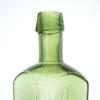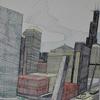A ‘NEW AND NATIVE’ BEAUTY: THE ART AND CRAFT OF GREENE & GREENE AT THE MUSEUM OF FINE ARTS, BOSTON, CELEBRATES THE VISION OF RENOWNED 20TH-CENTURY ARCHITECTS CHARLES AND HENRY GREENE
- BOSTON, Massachusetts
- /
- August 05, 2009
Famous for the ‘Ultimate Bungalow,’ the Designers Helped to Create the California Style
Beauty with a purpose was the guiding aesthetic for Charles and Henry Greene, acclaimed architects and designers of the American Arts and Crafts Movement in the early 20th century. Known for their signature “ultimate bungalows,” the brothers designed “total living environments” for their clients, including the architecture, furnishings, and even the surrounding landscape. Their unique vision embraced an appreciation of nature and the return to hand-craftsmanship in a world increasingly dominated by the uniformity of the mechanized age.
A celebration of their work, offering the most comprehensive examination to date of their contributions, is presented in A “New and Native” Beauty: The Art and Craft of Greene & Greene at the Museum of Fine Arts, Boston (MFA), July 14 through October 18, in the Lois and Michael Torf Gallery. The exhibition is supported at the MFA by the Windgate Charitable Foundation, the MFA Associates/MFA Senior Associates Exhibition Endowment Fund, and the Felicia Fund. Programming support is provided, in part, by Guardian Stewardship. Support for the national tour of the exhibition is provided by the Ayrshire Foundation, the Henry Luce Foundation, the Steve and Kelly McLeod Family Foundation, the Windgate Charitable Foundation, Joseph D. Messler, Jr., the Ralph M. Parsons Foundation, and Margaret Winslow.
A “New and Native” Beauty has been organized by The Gamble House, USC, and The Huntington Library, Art Collections, and Botanical Gardens, California, in cooperation with the Renwick Gallery, Smithsonian American Art Museum, and the Museum of Fine Arts, Boston.
A “New and Native” Beauty marks the centennial of the Greene brothers’ finest work in architecture and the decorative arts (1907–1910), including iconic Greene and Greene creations for the Robert R. Blacker house, many of which are reunited for the first time in decades. The title of the exhibition was drawn from a special citation from the American Institute of Architects in 1952 honoring Charles and Henry Greene as “formulators of a new and native architecture.” The Greenes’ simple but refined designs, innate understanding of the natural world, and extraordinary attention to detail made them leading architects in America and very influential on the emerging American modernism movement. A “New and Native” Beauty explores important points in the evolution of their unique design vocabulary and identifies the many influences on their work. It highlights approximately 120 objects in a variety of media, including beautifully inlaid furniture, artfully executed stained glass and metalwork, and rarely seen architectural drawings and photographs. These are on view throughout the Torf Gallery, which has been designed to reflect the Greenes’ aesthetic with its soft color palette and detailed mahogany moldings.
The exhibition unfolds chronologically, featuring objects representative of 25 of the best known Greene and Greene commissions. The first gallery introduces the Greenes and highlights the period when the brothers studied architecture at the Massachusetts Institute of Technology (MIT) and worked in Boston (1888–1893), a unique feature of the MFA installation of the exhibition. This gallery examines important influences that the Greenes encountered in Boston, including the Japanese collection at the Museum of Fine Arts, Boston, and the Arts and Crafts movement.
“The MFA is delighted to welcome back Charles and Henry Greene, who spent pivotal years here in Boston as students at MIT and apprentice architects in the late 19th century,” said Malcolm Rogers, Ann and Graham Gund Director of the MFA. “At that time, the Museum had just formed the most extensive Japanese collection in the West, and it is interesting to see the profound influence the arts of Japan had on the Greenes’ inventive style.”
To emphasize the relationship between the Greenes and the Museum, approximately 80 Japanese decorative objects, including ceramics and metalwork, have been added to the Boston exhibition. These objects are displayed in the manner in which the Greenes would have seen them in 1890. The ceramics, dating from the 17th through 19th centuries, are drawn from the MFA’s extensive Edward Sylvester Morse Collection of Japanese pottery, and the intricately decorated metal tsubas, or sword guards, are from the MFA’s William Sturgis Bigelow Collection. This first gallery also displays furniture of the American Arts and Crafts movement from the MFA collection, including works by Frank Lloyd Wright and Henry Hobson Richardson. The simple, structural style of the Arts and Crafts movement was greatly influential on the Greenes’ developing sense of style.
The second section of the exhibition explores the peak years of the Greenes’ partnership, featuring objects from the brothers’ “ultimate bungalows,” distinguished by their overhanging eaves and open floor plans. Carefully organized groupings emphasize the unified design of some of their most famous commissions and include such masterworks as the Living room armchair from the Blacker house, the Bedroom chiffonier from The Gamble House (both of Pasadena, CA), and the Fall-front desk from the Tichenor house (Long Beach, CA). In the last section of the gallery, which focuses on the later years of their careers, a video is included that shows modern-day views of some of the Greenes’ key commissions. Also on view are drawings and plans created by Greene and Greene, interactive displays featuring wood inlays and joinery, and didactic comparisons of Greene and Greene metalwork and furniture.
Charles Sumner Greene (1868–1957) and Henry Mather Greene (1870–1954) were born in Brighton, Ohio, now part of Cincinnati, but spent their youth on their mother’s family farm in West Virginia where they developed their love of nature. As teenagers, they studied industrial arts at the Manual Training School of Washington University in St. Louis, later completing their education at the School of Architecture at MIT in Boston, the first such school in the nation. Located in the Back Bay during the late 19th century, the Institute was near the MFA’s original building at Copley Square. The painting Copley Square with Trinity Church and the Old Museum (MFA, 1911), by K. Calhoun, captures the look of this period and is included in the exhibition, which also showcases schoolbooks used by young Charles and Henry Greene.
During their years in Boston, the Greene brothers lived in several boarding houses on St. James Avenue, near to both MIT and the MFA where they both took classes. At that time, the Museum’s rapidly growing Japanese collection was fueling a citywide, and nationwide, craze for all things Japanese. Through the foresight and enterprise of a small group of pioneering connoisseurs of Japanese art, including Edward Sylvester Morse, Ernest Francisco Fenollosa, and William Sturgis Bigelow, the MFA became the first American museum to have a gallery dedicated to Japanese art, and in 1890 Fenollosa became its first curator. The Greenes would have encountered the impressive collections of Japanese paintings, pottery, metalwork, costumes, and textiles whose influence can be seen in their later, mature work. Japanese tsubas became the inspiration for doorbells and light switches, and temple motifs were often used for bracketed beams and columns.
In addition to Japonism, the Arts and Crafts Movement (1890–1920) also was becoming popular among a group of Boston’s most influential architects, designers, arts patrons, and educators. This international design philosophy was developed by two Englishmen, critic John Ruskin and designer William Morris, who denounced mass-produced machine art, and instead advocated a return to beauty and nature, an appreciation of craftsmanship and integrity of materials, and an idealized vision of communal medieval life. Surrounded by such influences, and inspired by the work of leading Boston architect Henry Hobson Richardson and Harvard University fine arts professor Charles Eliot Norton, the Greenes completed their studies and apprenticed at leading architectural firms in Boston. In 1893, after losing their jobs in a nationwide financial downturn, the brothers departed for Pasadena to join their parents, who had relocated there. The following year, they established their architectural firm, Greene and Greene, and launched a relatively brief but legendary partnership.
“The influences that Charles and Henry Greene encountered in Boston shaped their artistic philosophy and style for their entire careers,” said Nonie Gadsden, Carolyn and Peter Lynch Curator of Decorative Arts and Sculpture, Art of the Americas, who is the curator of the exhibition in Boston. “We emphasize these influences by recreating some of the Japanese art displays that the brothers saw at the MFA and adding works from the Museum collection by some of their Arts and Crafts contemporaries, including Henry Hobson Richardson.”
In addition to exploring influences on the Greenes, A “New and Native” Beauty highlights the evolution of their unique design vocabulary, use of traditional wood joinery, and creation of a new California aesthetic that suited the climate, landscape, available materials, and the lifestyle of the owner. In formulating their “total living environment,” the brothers gave careful consideration to every detail—from the structure of the house itself down to light fixtures, textiles, and andirons—resulting in a unified work of art. Helping them achieve their vision were talented craftspeople, such as Peter and John Hall, Scandinavian furniture makers and millworkers who skillfully executed the Greenes’ designs. Exquisite examples of their work include the teak and ebony Blacker house Entry hall bench (1909–1909, Courtesy of American Decorative Art 1900 Foundation), and the strikingly modern Bolton house Hall chair (1907, Guardian Stewardship). The furniture is complemented by the Greenes’ stunning designs in stained glass and lighting, including the colorful stained glass and mahogany Reeve house Entry hall panel (1904, Private Collection), and the pagoda-inspired copper and glass Libbey house Exterior wall lantern (1905, Private Collection). The lamps, lanterns, and stained glass panels included in the exhibition are lit to evoke a warm, home setting.
A “New and Native” Beauty features photographs, drawings, and descriptions of the Greenes’ major architectural commissions including houses for civic leader Adelaide A. Tichenor (1905, Long Beach, CA), lawyer-financier Henry Robinson (1906, Pasadena, CA), Proctor & Gamble scion David Berry Gamble (1908, Pasadena, CA), retired lumberman Robert Roe Blacker (1909, Pasadena, CA), and Cordelia Culbertson and her sisters (1913, Pasadena, CA). Archival photographs are juxtaposed with video footage showing selected house exteriors as they look today. Only The Gamble House, now a historic house and museum, retains all of its original furnishings and fixtures designed by Greene and Greene, as many of the other homes have either been stripped of their contents, or demolished. The Robinson house dining room, complete with furnishings and interior woodwork, is recreated at The Huntington in San Marino, California.
By 1916, the brothers went their separate ways, and in 1922 they officially dissolved Greene and Greene. In the ensuing years, their designs fell out of fashion, but were rediscovered after World War II, when they were praised for inspiring American modernism, reaffirming the vision set
forth by Charles Greene when he said, in 1915: “I seek ’til I find what is truly useful and then I try to make it beautiful.”
EXHIBITION ORGANIZATION
A “New and Native” Beauty is co-curated by Edward R. Bosley, James N. Gamble Director of The Gamble House, and Anne Mallek, Gamble House curator. The exhibition has been on view at The Huntington Library, Art Collections, and Botanical Gardens in San Marino, CA, and at the Smithsonian American Art Museum’s Renwick Gallery in Washington, DC, followed by the Museum of Fine Arts, Boston. The catalogue A “New and Native” Beauty: The Art and Craft of Greene & Greene accompanies the exhibition. It was published in 2008 by Merrell Publishers Limited of London, in association with The Gamble House/USC, and is available in the MFA Bookstore & Shop and at mfashop.com. The price for the hard-cover version is $75, and soft cover is $45.
ADDITIONAL INFORMATION/IMAGES
Please contact Mary Keith at 617.369.3448 or mkeith@mfa.org for more information about the exhibition, or for digital photography.
617.267.9300
http://www.mfa.org
About Museum of Fine Arts, Boston
The Museum of Fine Arts, Boston (MFA), is recognized for the quality and scope of its encyclopedic collection, which includes an estimated 450,000 objects. The Museum’s collection is made up of: Art of the Americas; Art of Europe; Contemporary Art; Art of Asia, Oceania, and Africa; Art of the Ancient World; Prints, Drawings, and Photographs; Textile and Fashion Arts; and Musical Instruments. Open seven days a week, the MFA’s hours are Saturday through Tuesday, 10 a.m. – 4:45 p.m.; Wednesday through Friday, 10 a.m. – 9:45 p.m. General admission (which includes two visits in a 10-day period) is $17 for adults and $15 for seniors and students age 18 and older. Admission for students who are University Members is free, as is admission for children 17 years of age and younger during non-school hours. No general admission fee is required (after 4 p.m.) on Wednesday evenings, although voluntary donations are welcome. Gund Gallery exhibitions, such as Titian, Tintoretto and Veronese: Rivals in Renaissance Venice, are ticketed events that require an additional fee. The Museum is closed on New Year’s Day, Patriots’ Day, Independence Day, Thanksgiving, and Christmas. For general visitor information, visit the MFA website at mfa.org or call 617.267.9300.
















31100x100_c.jpg)